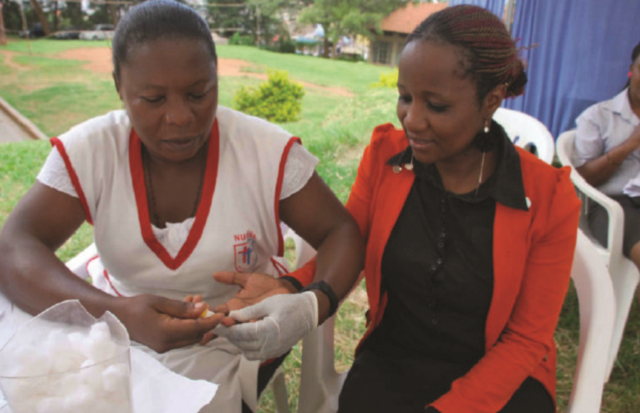
Rate at which girls in the age bracket of 14-24 are getting infected alarming
When it comes to the HIV/AIDS pandemic, Uganda is classified as a high burden country by UNAIDS, the international agency that is at the helm of mustering a joint response to the disease.
High numbers of persons living with HIV remain despite three decades of a robust fight against infections. Experts say,apart from continuing spread of HIV, increased longevity among persons living with HIV contributes to high figures.
Dr. EliodaTumwesigye who has been involved in Uganda’s HIV/AIDS prevention programmes since 1991, says improved care for HIV/AIDS patients means the number of people who are dying is less. Provision of Anti-Retroviral Therapy (ARTs) has widened from about 330,000 in 2011 to about 750,896 in 2014.
On the other hand, although the number of new cases has reduced, especially among children, there is a significant number of people with new infections. He blames sexual behaviour and practices that promote HIV transmission that have possibly not significantly changed.
“The number of people who practice unprotected sex is still high; condom use has not increased and people still have multiple sexual partners.
“Still, the prevalence rate should have fallen if everybody who is HIV positive were put on treatment as recommended by the World Health Organization,” Dr. Tumwesigye told The Independent on Nov.28, “Unfortunately Uganda has not yet started that intervention.”
Tumwesigye says when you put HIV-infected people on treatment within six months, the amount of the virus in the blood and semen significantly reduces and the chances of transmission become relatively low.
The last two rounds of Uganda’s AIDS Indicator Survey show that HIV prevalence in the general population in Uganda increased from 6.4% in 2004/5 to 7.3% by 2011 among adults.
There are no new figures on prevalence but the resurgence in 2011 implied that about 1.6 million people are now living with HIV. Between the years of 2005 and 2013, the number of AIDS-related deaths in the country is reported to have decreased by an estimated 19% while AIDS related deaths reduced from 67,000 to 63,000 in 2010 and 2013 respectively.
But by the end of 2013, Uganda had 140,000 new cases of HIV infections, accounting for 70% of the world’s total increase—the third largest increase in any country.
In the East African region, according to a 2013 UNAIDS report, Uganda’s HIV prevalence— the number of people living with HIV (new cases added onto those already infected) at a specific point in time expressed as a percentage of the population— is the highest at 7.3%, followed by Kenya at 5.3%, Tanzania (3.0%) and Burundi (1.1%).
The report says young women in sub-Saharan Africa are particularly at risk of HIV-AIDS, with 75% of new infections among adolescent girls between the ages of 10 and 19. In 2013, HIV prevalence among young people aged 15-24 in Uganda was estimated at 4.2% for women and 2.4% men respectively.
The UNAIDS report noted that every week, at least 570 young women aged 15-24 get infected with HIV in Uganda. In Africa, Uganda is second to South Africa where 2,363 get infected with HIV over the same period, compared to 491 for Tanzania,468 for Kenya, and only 25 for Rwanda.
But HIV prevalence also remains higher in key populations particularly sex workers (35%-37%); fisher folk (22%-29%), long distance truck drivers (25%), uniformed services personnel (18.2%) men who have sex with men (13.7%) and boda-boda taxi men (7.5%).
Sylvia Nakasi, the policy and advocacy specialist at the Uganda Network of AIDS Services Organizations (UNASO) told The Independent on Nov.24 that the rate at which young girls in the age bracket of 14-24 are getting infected with HIV is particularly alarming.
Health experts blame gender-based violence including sexual abuse and a lack of access by girls to education, health services, social protection and information about how they could cope with these inequities and injustices.
In 2013, the percentage of young women and men aged 15-24 who correctly identified ways of preventing the sexual transmission of HIV and who rejected major misconceptions about HIV transmission was at an estimated 38.9%.
At the close of 2013, the percentage of young women aged 15-24 who had had sexual intercourse before the age 15 was 13.1%. On the other hand, men in the same age bracket were estimated at 11.9%.
The risks and choices adolescent girls make are shaped by their early experiences, and radical transformations are required to break these barriers.
According to the new National HIV/AIDS Strategic Plan 2015/16—2019/2020, the key drivers of HIV incidence in Uganda continue to revolve around high risk sexual behaviour, including early sexual debut, multiple sexual relationships, inconsistent condom use and transactional sex.
There also seems to be low individual level risk perception, high sexually transmitted infections prevalence, low utilization of antenatal care and delivery services, and low uptake of safe male circumcision services.
 The Independent Uganda: You get the Truth we Pay the Price
The Independent Uganda: You get the Truth we Pay the Price



